How to stop slugs in your allotment or garden, naturally
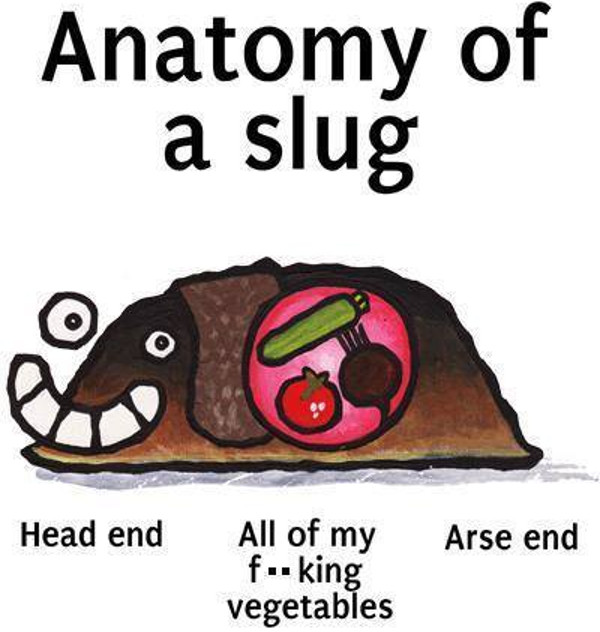
Ludwig Appeltans shares his top tips on how to stop slugs naturally and keep your garden or allotment thriving – no slug pellets needed!
There are many tips on how to fight these invertebrates circulating around allotments and gardens – some are fables, some are more effective than others. The reality is that no single thing does the trick. In short, the solution is to create an ecosystem in your garden that will help to create a balance.
A plague is caused by an imbalance, a lack of predators that keep the population of slugs under control. Sounds easier than it is, but if you love your garden it greatly increases the joy and once established it looks after itself!
A number of years ago I started a forest garden in the middle of a very wet woodland with a disturbed ecosystem, in the midst of a slug stronghold. I could easily collect a large jarful of slugs at dusk. After an intensive research and learning process with many failures, I only had to go out with a torch in the dark once every week or so and even then I only found a few. I was able to grow anything I liked without losing many plants to slugs. Besides the only real certificate for Organic Food are holes in your salad leaves. I have had to learn to live with some losses but still feel I can shout “Victory!” Here is what I learned so far: (if you have any tips of your own, let me know please in the comments below).
Step 1: Know your slugs
There are 30 native species in the UK and some are more harmful than others. The large black slug doesn’t do much damage at all as they prefer rotting matter, dung and carrion above living plants. The garden slug is the opposite, attacking anything that even slightly resembles an herbaceous plant.
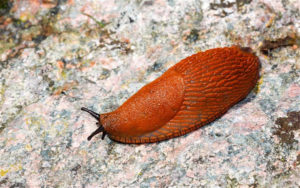
There is the dreaded invasive Spanish Slug. It is more resilient that the native ones, is larger, can tolerate drier conditions and has more offspring.
The most harmful slugs

Less harmful slugs

This is a Leopard Slug. The reports are conflicting. Some people claim they are a gardeners friend because they eat only rotting matter, leaves and other slugs. Other say that they also eat flowers and fruits. Their very special mating ritual is a strong argument to keep them alive, maybe even worthy of growing some vegetables especially for them! Does anyone have any experience with them in their garden?

Some slug characteristics
-
- Slugs don’t have teeth, so rasp vegetables rather than chew them. If it is very quiet you can hear them eat.
- Some experts claim that it is the younger slugs that do the most damage as older slugs eat more compost than green leaves. My experience is different – both are a nuisance. The big ones have grown big by eating my plants, so I make no distinction!
- Slugs are nomads, unlike snails who carry their home on their back but, if deported less than 20m away, will come back to the same spot.
- They are nocturnal animals and during the day hide underneath flowerpots, stones, leaves etc.
- Slugs have a role to play in the ecosystem. As well as being excellent recyclers, they eat the weakest plants first. So they play a role of strengthening your plant gene pool. If you have a strong gene pool and rich soil, you won’t have a slug problem. A slug plague is an indicator of a lack of predators but also of a soil lacking nutrients. Plants need these nutrients to build defences.
- Because they have no skeleton they can squeeze through the tiniest holes – don’t make breathing holes in the slug collecting jar (as I painfully learned).
- Slugs eggs are gelatinous, mostly pale and can be found in small clusters under rocks, in plant containers and similar safe locations.
- Slugs love moisture and water. A dry garden at night time reduces the slug damage significantly. If you need to water, consider watering the garden early in the morning instead of the evening.
Step 2: Correct the imbalance
Introduce and encourage predators
These are examples of native slug predators in Scotland, you might have to do more of your own research for native predators, local to you.
- Nematodes: This is the quickest, most effective, least labour intensive biological method to secure a slug free area for up to 6 weeks. One treatment for about 200 square meter costs a little more than £20 at the moment I write this article. Nematodes are microscopically small worms that parasitise and kill slugs. The nematodes are watered on to the soil surface, who then actively search for their prey and invade it. Special bacteria, living in symbiosis with the nematodes, are released, multiply rapidly and act as food for the nematodes. An infected slug stops feeding within 3 to 5 days and then displays a typical swelling. The nematodes multiply inside the slug and when it starts to decompose, a new generation of nematodes spreads and starts looking for the next prey. The nematodes work for up to 6 weeks. This cure has a serious side effect though. It is too successful. By eliminating all the slugs, we also also taking away food for the predators that eat the slugs or its eggs and we drive away the predators in a search for food. The result of that is that we create the perfect scenario for a new slug plague: An area rich in food for slugs with few predators. Party time! In effect we become addicted to the quite expensive cure. In my permaculture design journey so far, I have only used it in one garden and only on a small part of it, because the plague was so bad.
- Frogs: Having a pond in the garden has many benefits. It greatly increases wild life and the beauty. It allows birds and insects to drink. And you can grow food and flowers in the pond and on the edge. If you don’t keep fish, newts, ducks or herons, you can keep frogs. Apparently it is illegal to collect frog spawn from the wild without permission. I understand that wildlife needs to be protected against ignorance and maltreatment, so I will encourage you to do loads of research for yourself and I definitely will NOT encourage you to go to a pond nearest to your garden to gently and with great care collect only a little bit frog spawn with some pond water for your own haven for wild life. Frogs are only fertile after two years, so I will NOT encourage you to do it two years in a row to prevent you finding that you have a frog population gap. Tadpoles do need food, other wise they will eat each other. When they are young some lettuce leaves other other greens are enough, when they get bigger they will need more protein. In the form of fish flakes, chopped up worms or slugs, squashed snails, Marmite sandwiches or bits of raw chicken. The little frogs hopping about hunting for slugs are delightful. It is a joy to see them! It encouraged me to thread gently in the garden, which can only be a good thing.
- Toads: Toads do not need a pond. If you provide enough moist hiding spaces they will most likely be attracted by the abundance of food.
- Slow worms: These beautiful creatures are becoming rare and are strictly protected. It really is not a good idea to pick them in the wild. So the only way to get them in your garden is to provide a good shelter and hope they turn up. A sheet of corrugated iron or black plastic in a slightly raised and sunny spot near the compost heap seems best (Dry and warm). Slow worms feed mostly on slugs. If you have them, protect them well they are a great ally! Sadly, pheasants eat slow worms.

- Hedgehogs: It’s a debatable issue whether it is ethically justified to keep them in the perimeter of a group of allotment or large garden. I think it might be – if the hedgehog would otherwise have been culled and has a large enough habitat that is also able to provide it with all the essentials it needs. North Uist and Benbecula on the West Coast of Scotland have had to take drastic steps to save the ground nesting birds as the introduced hedgehogs were wiping them out by eating the eggs. Uist Hedgehog Rescue is a charity trying to save (deport rather than kill) hedgehogs from a certain death. I received the hedgehogs in the picture from the Hessilhead Wildlife Rescue Trust. It is not easy to persuade them to give you a hedgehog as they might want to come and look for themselves whether it is safe for hedgehogs. A road or badgers nearby would give you a negative answer. I trust the experience of the HWRT charity to decide if your land is big enough and has all that the hedgehogs need. In my case my 3 acres were deemed large, safe and rich enough to receive them.If you can’t get one from a charity, please don’t capture them in the wild. They are an endangered species. All you can do is provide it with all it needs and hope they will get attracted by your rich permaculture ecosystem and turn up themselves. If you are lucky enough to have a hedgehog, don’t treat it as a pet. It is a wild animal after all. A place to hide during the day and some decent fencing to stop it going on the road is important as protection. Make sure there is enough food for it in the garden in the form of a healthy ecosystem (hedgehogs eat mainly worms, beetles and other insects besides slugs), don’t leave out cat food (despite claims from some charities that this is needed.) It attracts rats and other vermin, don’t give it milk and don’t de-flea it as that would kill it. Hedgehogs are wild animals. people kept asking me what I called them. I didn’t name them because I see them as wild animals.
- Shrews: eat slugs.
- Song thrushes: are famous as snail-eaters. Putting stones in the garden that they can use as an anvil attracts them.
- Blackbirds and mistle thrushes: eat both snails and slugs.
- Ducks: Ducks are great slug predators. We are experimenting with both breeds of Khaki Campbells and Indian Runners who are the best carnivores – other breeds might eat more of your vegetables. Our initial findings are that the Kakhi Campbells are the most carnivorous, but our Indian Runners have really adorable personalities and are much smarter. Our mascot has stolen many hearts. Training the ducks is helpful. It is much more effective if they are tame. Hatching the first generation yourself from an incubator helps to bound them to you. They will teach their own off spring to be close and trusting to you. You can also train them to associate certain words or whistles with food so that you can go hunting together. If you teach them to associate a movement of your hand with tasty food, you can use that to teach them to eat new pests. Letting your ducks in your garden is not always possible. They are not smart enough to be trained to not be trampling on young seedlings. And when slugs are depleted they might go for your vegetables. You could walk them trough your garden hunting for slugs or take them weeding with you. You could have your garden in between the duck hut and the pen, thereby allowing the ducks a good munch in the morning and evening while on the way to and from home. You could also design your garden in a way that separates the ducks from your delicate vegetables with ducks as a moat around your garden or with raised beds. Ducks do eat frogs and worms. I wonder if they eat slow worms too.
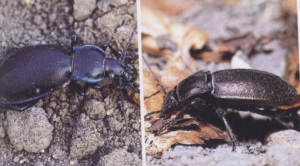
- Beetles: Carabid beetles are very effective slug predators – the larvae and beetles eat the eggs and the tiny slugs. If suitable homes are provided they can appear in huge numbers! If you have these beetles in your garden, you can help them by providing a good home for them. Some patches between your beds with tough grasses or sedges, some straw or hay in an upside down plastic box (you can wrap the boxes with some fine mesh chicken wire to keep mice out that eat beetles), some stones for the beetles to live under, raised beds, well drained soil are all good. The beetles are tirelessly on the hunt all night! Larger gardens or farms can encourage these animals by making a beetle bank.
- Centipedes: Centipedes are carnivorous nocturnal hunters. Learn to distinguish between the millipedes and centipedes, as millipedes are herbivores and love young seedlings. The centipedes I know are only beneficial to us. Rumours or people being bitten are going around, but I have never met anyone in Scotland who has been bitten by them. Centipedes like it moist, so they live in leaf litter, under stones, in rotting wood, etc. If you observe them closely, you can see that they are equipped with some ferocious weapons. I have lots of respect for them.
Control by prevention
It is better to water in the morning instead of the evening. It is estimated that this can reduce the damage by 80%. If you would water the decoy plants in the evening but not your crop, it might even be higher.
Control by distraction
There are plants out there that slugs like better than your vegetables. If you grow them in your garden, they will attract the slugs and all you will need to do is pick them up at dusk or put a slug trap nearby. Lawn Camomile is my favourite because it is most effective in spring when my seedlings are small and most vulnerable. It is a perennial, so when the annuals are at the most vulnerable, the camomile is in full swing already. Rubbing the plant whilst looking for slugs releases the scent that attracts the slugs. I use it a lot. Try to discover what slugs like better than your vegetables. Experiment with cut salad leaves and juicy plants left out between your plants. Other people report excellent results with Bok Choi and Chinese Cabbage.
Control by deportation or murder
This part of the exercise is the most difficult and contentious. In the early part of my ‘gardening career’ I used to catch slugs in a jar and deport them. Until I realised that, in essence, I was transporting an imbalance from one ecosystem to another, thereby creating a problem elsewhere. For the sole reason that I was too much of a coward to deal with the problem myself. I wasn’t even solving the problem because deporting slugs and depositing them at a distance, creates a high slug pressure that get deflated by the low slug pressure that sucks them back in! Transporting them elsewhere is like mopping up water while the tap is running – now I kill them without mercy with a method as humane as I can come up with. After all, if there had been enough predators they would more than likely have become prey. The most effective way of finding them is to go out with a torch just after dusk or at a miserable grey wet day– make sure to look on the underside of the vegetable leaves. Let the plant damage and slime trails guide you. I feed some to my tadpoles- they fight for them! (and I hope it helps them to develop a taste for slugs when they are older!) Picking slugs by hand can be a messy business. Some species produce a slime that is really persistent. Some people use tongs, chopsticks or garden gloves.
These are a few of the most used murder weapons:
- Jar: You can drown them by putting them in a jar filled completely with water and keeping the lid screwed on tightly. Some say soapy water kills them. A bucket with water is not good enough, the slugs will just crawl out again. When I fist caught slugs in a jars to deport them, I made tiny holes in the lid to help them breathe. The next morning the jar was empty. Needless to say I never did that again!
- Knitting needles: Are useful to make slug shish kebab!
- Beer traps: After trying several designs this is the winner:
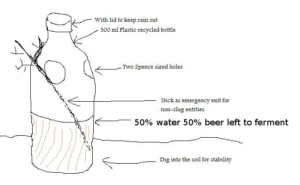
- Slugs seem to get drunk and forget to crawl out again and drown.The slugs are attracted by the fermentation gasses of beer. Any cheap lager or homebrew is good, though ales and Guinness are best. Use a beer that has a good fermentation. The bait works even better when the slug corpses become part of the fermentation process. At that point it is rather smelly, yet effective, so top up the beer or replace after a while, as desired. Beer of 2% is enough. If a higher percentage, dilute the beer with water to reduce costs. Other creatures fall in sometimes too, especially the predator beetles mentioned above. They don’t get drunk and do want to get out again – a stick helps as an exit ladder. Also try to make sure that the entry holes are a bit above soil level. Slugs have no problem with the smooth plastic surfaces, unlike other creatures. Place the traps at the edge of the beds. If you place them in the middle, slugs might get distracted by your juicy vegetables on the way to the pub.
- Other traps: Many other traps can be used. Grapefruit halves, flower pots, cardboard, anything dark and moist will be favoured by the slugs as a hiding place during the day. It seems they like stones to hide under better than logs. Inspect and capture at your leisure.
- Sharp knife: My preferred method at the moment is a sharp knife. I use it flick the slugs of the plant onto the soil surface and behead the poor things and leave them as food for other predators. I think it is the quickest death and the most convenient as a pocket knife is easily carried on you as standard gardener equipment.
- Sharp pointed scissors: these are useful to cut the slugs, the points allow to cut the smaller ones too.
- Some people suggest to eat the slugs ourselves. I agree that from a permaculture point of view, this seems the most efficient way to turn a problem into a solution, but I prefer to insert a stage to the recycling of the nutrients: ducks. To be honest, the duck eggs are much more appealing to me than boiled slugs. Although many people disagree with me: read more how about how to eat your slugs here and more about slug control with ducks here.
Border control
- Copper: Slugs don’t like to crawl over copper. With some cleverness, one can come up with some really effective borders. A dozen or so pennies stuck into the soil around a seedling can form a border. A stripped electrical cable is even better and cheaper. With some imagination, a seedling or potting table can be very large and still only have 4 legs, with copper cable wound around them. To protect a precious plant, strip an old cable from it’s plastic insulation – you can use a proper stripping tool, but I press it against a hot wood burning stove until it is soft and then strip it using my fingernails or a knife. Cut the top and the bottom of a recycled plastic bottle. Wrap the cable a few times around it with one or two loops in it, fasten it to the bottle with duck tape through the loops and flatten the copper loops to the plastic – done! Dig the plastic in the soil so that slugs don’t crawl underneath.Tip: If you use sticks to support the plant, wrap copper around the sticks too. Make sure none of the leaves touch the ground or any weeds touch the plant. Slugs can’t fly but they know how to find shortcuts! Clean the copper every year helps keep it effective.

- Copper with a charge. This video shows a really effective way to stop slugs. They claim that it doesn’t kill the slugs. (that one seems pretty dead to me though).
- Electric fence with a 9 Volt battery and galvanised wire.
- Egg shells: The sharp edges of eggshells help as a deterrent, but only when they are clean and dry. When peeling an egg, try to remove the inner membrane and rinse if needed. I put them in an empty cooking pot on my wood burning stove to help dry them out to keep them effective for longer. Be aware that rain quickly makes the eggshells lose their effectiveness.
- Slug repellent plants: Some plants are better at repelling than others. I read many reports on the internet that conflict with my experience. I know that chives work well. They are easily laid or tied around plants as well. I am experimenting further and will add my experience to this page.
- Wool: We have tried using wool as a border around little seedlings. It does seem to work a little. It is not as good as copper. We did discover that black wool cooked the seedlings in a really hot day. We’ll only be using white from now on. I do not recommend buying wool pellets as they are really expensive. A fleece from a farmer can be bought for a few pounds.

- Fences: tillsammansodlingen in Sweden are using a border to keep slugs out. It is simply a piece of plastic, dug into the ground and folded over at the top as in the picture. Slugs can’t turn the corner. They report that it is very effective, but they haven’t been able to eradicate the slugs that are trapped inside yet. I haven’t tried it yet. My initial thoughts are that it seems very effective. But I do consider that it does also stop other life. Like frogs, toads, beetles, slowworms etc,… from going in and out! I would suggest to be mindful about the predators when using this method. I wouldn’t want to be a toad trapped inside with no food left behind. I would love to hear from you how this is working for you.
- Borders of raised beds and gardens are best made from material that slugs don’t like that much. Stone borders are likely to home slugs better than wooden borders or woven willow. Using flat stones as traps would be move effective this way. Though stones also hide snakes and other predators. I have no experience yet with this. Anyone?
- Other borders: Many suggestions like: wood ash, alum, coffee grounds, sharp sand, charcoal dust, petroleum jelly, charcoal left overs after a barbecue, lava rock, roofing felt, are being made, most only work when the garden is dry, others affect the soil too much in high concentrations or might be toxic. As I live and work mostly in Scotland I have not bothered to investigate these options as they are not that useful to me. Borders that stop working when the ideal slug environment (wet weather) has arrived seem a bit pointless to me.
Do NOT try:
- Salt: Pouring salt around your veg will keep the slugs away indeed, but unless your plants like maritime conditions they will be affected too!
- Seashells: The sharp edges deter slugs from crossing, but they don’t decay like eggshells and can be a serious nuisance when weeding for many years to come.
- Slug pellets: Most are not organic and will kill the predators too. Even the organic ones are not wise to use: when the slugs die, the predators leave to find food elsewhere – leaving you dependent on the pellets.
- Organic slug pellets: Many Organic slug pellets containing Iron Phosphate or also called Iron III Phosphate are harmful to earthworms because they often contain other harmful ingredients that are not listed. Despite the claim that they are harmless, they are harmful to invertebrates like earthworms and maybe even to bees. The study that states such can be found here. Even if they were not harmful to other organisms, they are still wiping out an essential part of your ecosystem.
- Seaweed: This is sometimes advised to use as a mulch because it’s a natural repellent for slugs when it is salty, because slugs avoid salt. In permaculture we have a long term vision. If we keep adding salty seaweed to the soil for many years, our soil might become salty and that is detrimental to our plants. When mulching with seaweed, make sure it is well rinsed. Seaweed on the soil surface also attracts lots of flies.
- Diatomaceous earth: This is expensive and only effective in dry weather, in rain it dissolves. Slugs are worst in wet weather, so this is a serious waste of resources. It also kills all insects including those that predate on slugs. It might even be detrimental to the cause.
Step 3: Enjoy watching your plants grow!
Remember to accept some losses and accept the presence of some slugs. They will help keep your predators in your garden.
And please be grateful to your new found allies for the help.
I’d be grateful if you would let me have your suggestions and experiences.
The views expressed in our blog are those of the author and not necessarily lowimpact.org's
3 Comments
-
1clare704 April 16th, 2017
One small point – it’s no good keeping the soil dry to deter the slugs if you want to use nematodes – they move by swimming in the water that surrounds soil grains.
Dried coffee grounds are supposed to be an effective barrier.
I have loads of leopard slugs but I’ve never seen them on plants. Small black slugs are the worst. The big ones do a good job of cleaning up bird food. But in my garden anyway, snails are far worse than slugs. Unless they’re just more obvious.
-
2joshuamsikahutton April 17th, 2017
Timely piece!
-
3Andrew Rollinson April 18th, 2017
There is definitely a positive correlation between the application of slug pellets and garden slug infestations, in my experience. They are one of the things (along with weed n’ feed) that should be banned. Eduction (as ever) is needed. But it doesn’t help that pellets are listed on the RHS website.
I don’t apply the pellets but my former urban neighbours did. One or two (slugs) get killed but many more take their places. Whether this is immunity, avoidance, toxicity being passed up the food chain, or all three, I don’t know. In this situation, there were no hedgehogs (all killed by traffic) or ducks, but lots of birds and frogs. I was also told by the owner of a hedgehog sanctuary that hedgehogs don’t like slugs that much anyway.
Having lived and gardened in forest areas, there is no slug problem. You might see one or two per month, but vegetables can just be left unprotected.
I have tried eggs shells and copper but neither worked. I have also tried traps and killing the slugs, but, as you say, population ecology means that more come to take their places (if the environment is good). Interestingly, I once worked away from home for a year (with my urban garden – mixed vegetable plot, lawn, borders – left to run wild). The first summer back there were hardly any slugs. Maybe they like disturbance?




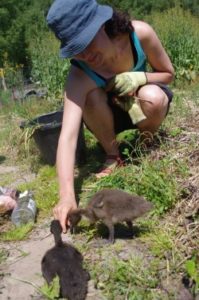
 Will nature deal with our crop and garden pests if we don’t intervene or use poisons?
Will nature deal with our crop and garden pests if we don’t intervene or use poisons?
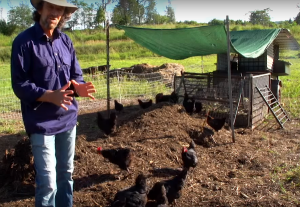 How a ‘chicken tractor’ can clear and improve soil, as well as getting rid of pests
How a ‘chicken tractor’ can clear and improve soil, as well as getting rid of pests
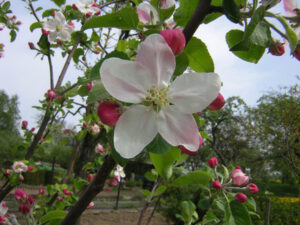 Fruit & vegetable growing guide for April
Fruit & vegetable growing guide for April
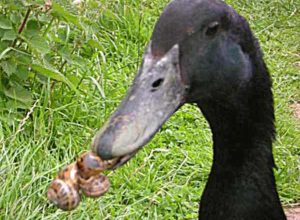 Slug control with ducks!
Slug control with ducks!
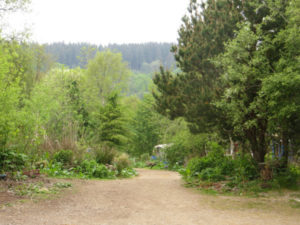 Would you like to become a member of a nature-based permaculture community on the Isle of Skye?
Would you like to become a member of a nature-based permaculture community on the Isle of Skye?
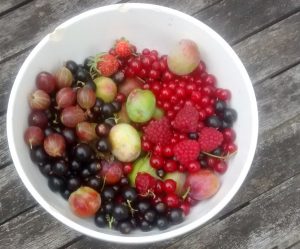 Low-impact & the city 13: How to get lots of fruit from a small garden with no work
Low-impact & the city 13: How to get lots of fruit from a small garden with no work
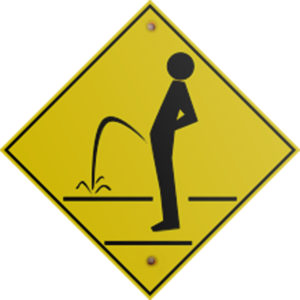 Taking the pee: is urine a good fertiliser?
Taking the pee: is urine a good fertiliser?
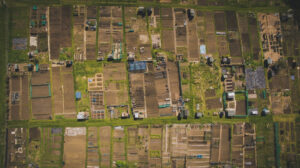 Zero food miles, zero packaging and plenty more: in praise of allotments
Zero food miles, zero packaging and plenty more: in praise of allotments
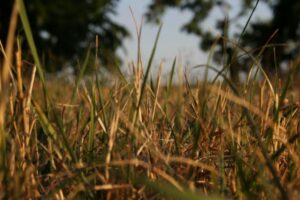 More Sustainable (and Beautiful) Alternatives to a Grass Lawn
More Sustainable (and Beautiful) Alternatives to a Grass Lawn
 Are metal raised beds safe for vegetables?
Are metal raised beds safe for vegetables?
 Composting
Composting
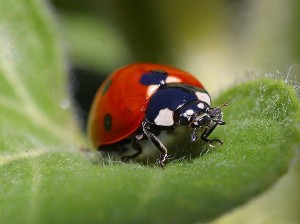 Natural pest & weed control
Natural pest & weed control
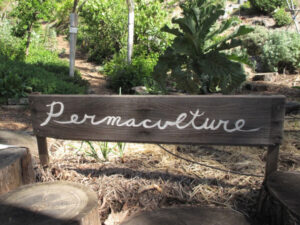 Permaculture
Permaculture
 Smallholding
Smallholding
 Soft fruit
Soft fruit


